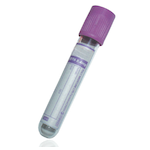Suitable Specimen Types
- EDTA Whole Blood
5 mL whole blood
Specimen Transport
Send whole blood to Ref Lab ASAP but if samples arrive late Friday sample preparation is required by BHH Lab. LAB STAFF - Centrifuge sample, remove and retain plasma, re-suspend cells in isotonic saline, re-centrifuge, remove supernatant and store.Sample Processing in Laboratory
UsualSample Preparation
Send whole blood to Ref Lab ASAP but if samples arrive late Friday sample preparation is required by BHH Lab. LAB STAFF - Centrifuge sample, remove and retain plasma, re-suspend cells in isotonic saline, re-centrifuge, remove supernatant and store.Turnaround Time
WeeklySample Stability
Plasma and cells at 4 ºC if requiredRed Cell Cholinesterase
General Information
There are normally 2 cholinesterase enzymes, one found predominantly in erythroocytes, lungs, spleen and nervous tissue (acetylcholinesterase). The other, found in plasma (cholinesterase or pseudocholinesterase), is synthesised mainly in the liver. Acetylcholinesterase is responsible for the prompt hydolysis of acetylcholine released at the nerve endings to mediate transmission of the neural impulse across the synapse. The degradation of acetylcholine is required for the depolarisation of the nerve so that it is repolarised in the next conduction event.Acetylcholinesterase may be measured for the diagnosis and monitoring of poisoning with organophosphate or carbamate insecticides such as Parathion, Sarin and Tetraethyl Pyrophosphate. Reduced levels will be observed with poisoning, whether acute or chronic. Levels will return to normal as the affected erythrocyte population is replaced. This is the preferred test, but see also Cholinesterase - plasma, which can be substituted and may be valuable to detect repeated exposure.
Use the code CHOLIR for RBC cholinesterase analysis for assessment of occupational exposure.
Patient Preparation
NoneNotes
For occupational monitoring, pre-exposure (off season) values will ideally be determined for later comparison with exposed values.Reference Range
Provided by Reference LabSpecifications
- EQA Status: No details
